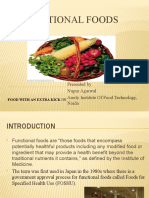Healthy Eating and Your Mood
Healthy Eating and Your Mood
Uploaded by
WanNurAtikahCopyright:
Available Formats
Healthy Eating and Your Mood
Healthy Eating and Your Mood
Uploaded by
WanNurAtikahOriginal Title
Copyright
Available Formats
Share this document
Did you find this document useful?
Is this content inappropriate?
Copyright:
Available Formats
Healthy Eating and Your Mood
Healthy Eating and Your Mood
Uploaded by
WanNurAtikahCopyright:
Available Formats
Healthy Eating
Simple Ways to Plan, Enjoy, and Stick to a Healthy Diet
Healthy eating is not about strict dietary limitations, staying unrealistically thin, or depriving
yourself of the foods you love. Rather, it’s about feeling great, having more energy,
improving your health, and stabilizing your mood. If you feel overwhelmed by all the
conflicting nutrition and diet advice out there, you’re not alone. It seems that for every expert
who tells you a certain food is good for you, you’ll find another saying exactly the opposite.
But by using these simple tips, you can cut through the confusion and learn how to create a
tasty, varied, and nutritious diet that is as good for your mind as it is for your body.
Healthy eating and your mood
We all know that eating right can help you maintain a healthy weight and avoid certain health
problems, but your diet can also have a profound effect on your mood and sense of wellbeing.
Studies have linked eating a typical Western diet—filled with processed meats, packaged
meals, takeout food, and sugary snacks—with higher rates of depression, stress, bipolar
disorder, and anxiety. Eating an unhealthy diet may even play a role in the development of
mental health disorders such as ADHD, Alzheimer’s disease, and schizophrenia, or in the
increased risk of suicide in young people.
Eating more fresh fruits and vegetables, cooking meals at home, and reducing your intake of
sugar and refined carbohydrates, on the other hand, may help to improve mood and lower
your risk for mental health issues. If you have already been diagnosed with a mental health
problem, eating well can even help to manage your symptoms and regain control of your life.
What is a healthy diet?
Eating a healthy diet doesn’t have to be overly complicated. While some specific foods or
nutrients have been shown to have a beneficial effect on mood, it’s your overall dietary
pattern that is most important. The cornerstone of a healthy diet pattern should be to replace
processed food with real food whenever possible. Eating food that is as close as possible to
the way nature made it can make a huge difference to the way you think, look, and feel.
The Healthy Eating Pyramid
The Harvard Healthy Eating Pyramid represents the latest nutritional science. The widest part
at the bottom is for things that are most important. The foods at the narrow top are those that
should be eaten sparingly, if at all. This Healthy Eating Pyramid shows daily exercise and
weight control in the widest, most important category. Fats from healthy sources, such as
plants, are in the wider part of the pyramid. Refined carbohydrates, such as white bread and
white rice, are in the narrow top. Red meat should also be eaten sparingly, while fish, poultry,
and eggs are healthier choices.
Building your healthy diet
While some extreme diets may suggest otherwise, we all need a balance of protein, fat,
carbohydrates, fiber, vitamins, and minerals in our diets to sustain a healthy body. You don’t
need to eliminate certain categories of food from your diet, but rather select the healthiest
options from each category.
Protein gives you the energy to get up and go—and keep going—while also supporting
mood and cognitive function. Too much protein can be harmful to people with kidney
disease, but the latest research suggests that many of us need more high-quality protein,
especially as we age. That doesn’t mean you have to eat more animal products—a variety of
plant-based sources of protein each day can ensure your body gets all the essential protein it
needs. Learn more »
Fat. Not all fat is the same. While bad fats can wreck your diet and increase your risk of
certain diseases, good fats protect your brain and heart. In fact, healthy fats—such as omega-
3s—are vital to your physical and emotional health. Including more healthy fat in your diet
can help improve your mood, boost your well-being, and even trim your waistline. Learn
more »
Fiber. Eating foods high in dietary fiber (grains, fruit, vegetables, nuts, and beans) can help
you stay regular and lower your risk for heart disease, stroke, and diabetes. It can also
improve your skin and even help you to lose weight. Learn more »
Calcium. As well as leading to osteoporosis, not getting enough calcium in your diet can also
contribute to anxiety, depression, and sleep difficulties. Whatever your age or gender, it’s
vital to include calcium-rich foods in your diet, limit those that deplete calcium, and get
enough magnesium and vitamins D and K to help calcium do its job. Learn more »
Refined Carbs and Sugar: The Diet Saboteurs
Carbohydrates are one of your body’s main sources of energy. But most should come from
complex, unrefined carbs (vegetables, whole grains, fruit) rather than sugars and refined
carbs. Cutting back on white bread, pastries, starches, and sugar can prevent rapid spikes in
blood sugar, fluctuations in mood and energy, and a build-up of fat, especially around your
waistline. Learn more »
Making the switch to healthy eating
Switching to a healthy diet doesn’t have to be an all or nothing proposition. You don’t have
to be perfect, you don’t have to completely eliminate foods you enjoy, and you don’t have to
change everything all at once—that usually only leads to cheating or giving up on your new
eating plan.
A better approach is to make a few small changes at a time. Keeping your goals modest can
help you achieve more in the long term without feeling deprived or overwhelmed by a major
diet overhaul. Think of planning a healthy diet as a number of small, manageable steps—like
adding a salad to your diet once a day. As your small changes become habit, you can
continue to add more healthy choices.
For example, choose just one of the following diet changes to start. Work on it for a few
weeks, then add another and so on.
Easy ways to switch to a healthy diet
Switching to a heart-healthy diet
DIETARY AIM TO…
ELEMEN
Switching to a heart-healthy diet
Fast food Eat one fewer fast-food meal per week. Make a sandwich at home or try a supermarket salad,
meals
for example.
Fruit Eat an extra serving of fruit every day. Blend frozen fruit into a smoothie or add fresh berries
to yoghurt for a delicious dessert.
Vegetables Eat an extra serving of vegetables every day. Add a side salad to your evening meal, for example.
Seafood Eat one serving per week. Replace a ham sandwich or fast-food lunch with a tuna salad.
Snack Cut one serving per week. Try a handful of nuts instead.
chips and
crackers
Desserts Cut one serving per week by replacing with fruit.
and sweets
Butter or Replace with a light drizzle of olive oil and use spices to add flavor.
meat fat
Source: Harvard Heart Letter, January 2018
Setting yourself up for success
To set yourself up for success, try to keep things simple. Eating a healthier diet doesn’t have
to be complicated. Instead of being overly concerned with counting calories, for example,
think of your diet in terms of color, variety, and freshness. Focus on avoiding packaged and
processed foods and opting for more fresh ingredients whenever possible.
Prepare more of your own meals. Cooking more meals at home can help you take charge of
what you’re eating and better monitor exactly what goes into your food. You’ll eat fewer
calories and avoid the chemical additives, added sugar, and unhealthy fats of packaged and
takeout foods that can leave you feeling tired, bloated, and irritable, and exacerbate
symptoms of depression, stress, and anxiety.
Make the right changes. When cutting back on unhealthy foods in your diet, it’s important
to replace them with healthy alternatives. Replacing dangerous trans fats with healthy fats
(such as switching fried chicken for grilled salmon) will make a positive difference to your
health. Switching animal fats for refined carbohydrates, though (such as switching your
breakfast bacon for a donut), won’t lower your risk for heart disease or improve your mood.
Read the labels. It’s important to be aware of what’s in your food as manufacturers often
hide large amounts of sugar or unhealthy fats in packaged food, even food claiming to be
healthy.
Focus on how you feel after eating. This will help foster healthy new habits and tastes. The
healthier the food you eat, the better you’ll feel after a meal. The more junk food you eat, the
more likely you are to feel uncomfortable, nauseous, or drained of energy.
Drink plenty of water. Water helps flush our systems of waste products and toxins, yet
many of us go through life dehydrated—causing tiredness, low energy, and headaches. It’s
common to mistake thirst for hunger, so staying well hydrated will also help you make
healthier food choices.
Moderation: important to any healthy diet
What is moderation? In essence, it means eating only as much food as your body needs. You
should feel satisfied at the end of a meal, but not stuffed. For many of us, moderation means
eating less than we do now. But it doesn't mean eliminating the foods you love. Eating bacon
for breakfast once a week, for example, could be considered moderation if you follow it with
a healthy lunch and dinner—but not if you follow it with a box of donuts and a sausage pizza.
Try not to think of certain foods as “off-limits.” When you ban certain foods, it’s natural to
want those foods more, and then feel like a failure if you give in to temptation. Start by
reducing portion sizes of unhealthy foods and not eating them as often. As you reduce your
intake of unhealthy foods, you may find yourself craving them less or thinking of them as
only occasional indulgences.
Think smaller portions. Serving sizes have ballooned recently. When dining out, choose a
starter instead of an entree, split a dish with a friend, and don't order supersized anything. At
home, visual cues can help with portion sizes. Your serving of meat, fish, or chicken should
be the size of a deck of cards and half a cup of mashed potato, rice, or pasta is about the size
of a traditional light bulb. By serving your meals on smaller plates or in bowls, you can trick
your brain into thinking it’s a larger portion. If you don't feel satisfied at the end of a meal,
add more leafy greens or round off the meal with fruit.
Take your time. It actually takes a few minutes for your brain to tell your body that it has
had enough food, so eat slowly and stop eating before you feel full.
Eat with others whenever possible. Eating alone, especially in front of the TV or computer,
often leads to mindless overeating.
Be careful about the foods you keep at hand. It's more challenging to eat in moderation if you
keep unhealthy snacks and treats at hand. Instead, surround yourself with healthy choices and
when you’re ready to reward yourself with a special treat, go out and get it then.
Control emotional eating. We don’t always eat just to satisfy hunger. Many of us also turn to
food to relieve stress or cope with unpleasant emotions such as sadness, loneliness, or
boredom. But by learning healthier ways to manage stress and emotions, you can regain
control over the food you eat and your feelings
It's not just what you eat, but when you eat
Eat breakfast, and eat smaller meals throughout the day. A healthy breakfast can
jumpstart your metabolism, while eating small, healthy meals keeps your energy up all day.
Avoid eating late at night. Try to eat dinner earlier and fast for 14-16 hours until breakfast
the next morning. Studies suggest that eating only when you’re most active and giving your
digestive system a long break each day may help to regulate weight.
Make fruit and vegetables a tasty part of your diet
Fruit and vegetables are low in calories and nutrient dense, which means they are packed with
vitamins, minerals, antioxidants, and fiber. Focus on eating the recommended daily amount
of at least five servings of fruit and vegetables and it will naturally fill you up and help you
cut back on unhealthy foods. A serving is half a cup of raw fruit or veg or a small apple or
banana, for example. Most of us need to double the amount we currently eat.
To increase your intake:
Add antioxidant-rich berries to your favorite breakfast cereal
Eat a medley of sweet fruit—oranges, mangos, pineapple, grapes—for dessert
Swap your usual rice or pasta side dish for a colorful salad
Instead of eating processed snack foods, snack on vegetables such as carrots, snow
peas, or cherry tomatoes along with a spicy hummus dip or peanut butter
How to make vegetables tasty
While plain salads and steamed veggies can quickly become bland, there are plenty of ways
to add taste to your vegetable dishes.
Add color. Not only do brighter, deeper colored vegetables contain higher concentrations of
vitamins, minerals and antioxidants, but they can vary the flavor and make meals more
visually appealing. Add color using fresh or sundried tomatoes, glazed carrots or beets,
roasted red cabbage wedges, yellow squash, or sweet, colorful peppers.
Liven up salad greens. Branch out beyond lettuce. Kale, arugula, spinach, mustard greens,
broccoli, and Chinese cabbage are all packed with nutrients. To add flavor to your salad
greens, try drizzling with olive oil, adding a spicy dressing, or sprinkling with almond slices,
chickpeas, a little bacon, parmesan, or goat cheese.
Satisfy your sweet tooth. Naturally sweet vegetables—such as carrots, beets, sweet potatoes,
yams, onions, bell peppers, and squash—add sweetness to your meals and reduce your
cravings for added sugar. Add them to soups, stews, or pasta sauces for a satisfying sweet
kick.
Cook green beans, broccoli, Brussels sprouts, and asparagus in new ways. Instead of
boiling or steaming these healthy sides, try grilling, roasting, or pan frying them with chili
flakes, garlic, shallots, mushrooms, or onion. Or marinate in tangy lemon or lime before
cooking.
Healthy Eating: A guide to the new nutrition – Harvard Medical School Special Health
Report
You might also like
- Healthy EatingDocument4 pagesHealthy Eatingمندازي يييNo ratings yet
- Chapter 2 EDITED MARGINDocument16 pagesChapter 2 EDITED MARGINFebryan KharismaNo ratings yet
- NewsletterDocument5 pagesNewsletterapi-257776463No ratings yet
- CLIL NI 1 Unit 3 Science PDFDocument2 pagesCLIL NI 1 Unit 3 Science PDFTin ArtNo ratings yet
- Healthy Eating HabitsDocument2 pagesHealthy Eating HabitsIngrid Ximena0% (1)
- How To Be HealthyDocument2 pagesHow To Be HealthyMARIA CAMILA MARTINEZ CHAVARRONo ratings yet
- Eat Well PlateDocument1 pageEat Well PlatePathan Imran KhanNo ratings yet
- Food PyramidDocument7 pagesFood Pyramidtriratnacom100% (1)
- Heal Good FactorsDocument2 pagesHeal Good FactorsAutismeyeNo ratings yet
- Healthy FoodDocument13 pagesHealthy FoodKayden0% (1)
- Reformulation Guide Sugars Aug2016Document27 pagesReformulation Guide Sugars Aug2016Surendra RamkissoonNo ratings yet
- Functional FoodDocument14 pagesFunctional FoodSumeyya Binte Bockthier100% (1)
- The Benefits of Regular ExerciseDocument3 pagesThe Benefits of Regular ExerciseAmir AshrafNo ratings yet
- Exp SC 4 - Chapter 01Document8 pagesExp SC 4 - Chapter 01megamind publication100% (1)
- Healthy EatingDocument7 pagesHealthy EatingPedro FilhoNo ratings yet
- Dietary Guidelines and Food GuideDocument5 pagesDietary Guidelines and Food GuideDanica Mae BianitoNo ratings yet
- Healthy Living: Longevity and The Art of Ageing WellDocument4 pagesHealthy Living: Longevity and The Art of Ageing WellHealthWise ClinicNo ratings yet
- Functional Foods: Presented by Nupur Agarwal Amity Institute of Food Technology, NoidaDocument9 pagesFunctional Foods: Presented by Nupur Agarwal Amity Institute of Food Technology, NoidaNupur Agarwal100% (1)
- Motivational Role of Free Mid-Day Meals On Learning Process in Basic Community Schools of Western NepalDocument7 pagesMotivational Role of Free Mid-Day Meals On Learning Process in Basic Community Schools of Western NepalInternational Journal of Innovative Science and Research Technology100% (2)
- Life With Diabets PDFDocument16 pagesLife With Diabets PDFNajam Us Saqib100% (1)
- B.SC - HonsNutrition and Dietitics 1 To 8 SemesterDocument111 pagesB.SC - HonsNutrition and Dietitics 1 To 8 Semesterkamlesh.1912No ratings yet
- Healthy Diet: Dietary RecommendationsDocument5 pagesHealthy Diet: Dietary RecommendationsLloli LlollaNo ratings yet
- Balance Diet Revision NotesDocument3 pagesBalance Diet Revision NotesCharya Jayaratne100% (1)
- Fat 041649Document17 pagesFat 041649sudiptasethy0No ratings yet
- Lesson 1 (Health) MalnutritionDocument16 pagesLesson 1 (Health) MalnutritionBigboss AguilarNo ratings yet
- Tim Ferris TLDRDocument5 pagesTim Ferris TLDRpradnyavj.1No ratings yet
- Healthy Way of LifeDocument3 pagesHealthy Way of LifeЛілія Русланівна Ковтонюк100% (1)
- ESPEN Guidelines On Nutritional Support For Polymorbid Internal Med PatDocument18 pagesESPEN Guidelines On Nutritional Support For Polymorbid Internal Med PatAmany SalamaNo ratings yet
- Nutrition 321-E-Lesson-4 PDFDocument21 pagesNutrition 321-E-Lesson-4 PDFteshome teklehaimanotNo ratings yet
- Pathophysiology of Short Stature (Specifically in Children)Document16 pagesPathophysiology of Short Stature (Specifically in Children)Dennis SukadanaNo ratings yet
- SMA AWiS Nutrition For Active WomenDocument2 pagesSMA AWiS Nutrition For Active WomenenergisemeNo ratings yet
- PDF Nutrition CM 1 CU 1 LEC WEEK 1Document27 pagesPDF Nutrition CM 1 CU 1 LEC WEEK 1Zharm MayNo ratings yet
- Final Draft Research PaperDocument8 pagesFinal Draft Research Paperapi-509970932No ratings yet
- Aim and Objective of Cooking FoodDocument20 pagesAim and Objective of Cooking FoodAneesh Ramachandran PillaiNo ratings yet
- Sugar Vs HealthDocument12 pagesSugar Vs Healthapi-172952819No ratings yet
- Lose Weight FormulaDocument1 pageLose Weight Formulalee mcneillNo ratings yet
- Multiple Sclerosis Nutritional Handout PDFDocument6 pagesMultiple Sclerosis Nutritional Handout PDFITageINo ratings yet
- Food LabelsDocument1 pageFood Labelspringle89No ratings yet
- History of Food As ScienceDocument13 pagesHistory of Food As Scienceaimee almario100% (1)
- Obesity Formula 27Document14 pagesObesity Formula 27Mahmoud ShabbanNo ratings yet
- Basic Nutrition Project (Diet Plan)Document22 pagesBasic Nutrition Project (Diet Plan)PAOLA CASTRONo ratings yet
- Healthy Food Habit and Good LivingDocument13 pagesHealthy Food Habit and Good LivingMohit ManglaNo ratings yet
- Food Nutrition PresentationDocument26 pagesFood Nutrition PresentationÁngel Casares FraileNo ratings yet
- Unit Plan-Health Healthy Eating and Habits January 5th-31stDocument22 pagesUnit Plan-Health Healthy Eating and Habits January 5th-31stapi-534505202No ratings yet
- Food and Diet: Sample Questions and Answers For IELTS Speaking ExamDocument26 pagesFood and Diet: Sample Questions and Answers For IELTS Speaking ExamPargol ShobeiriNo ratings yet
- Fcs 405 - Lab Planning SheetDocument2 pagesFcs 405 - Lab Planning Sheetapi-350693115No ratings yet
- Healthy Eating Assessment - Self AdministrationDocument3 pagesHealthy Eating Assessment - Self Administrationglygly guillaran100% (1)
- Importance of Healthy FoodDocument18 pagesImportance of Healthy FoodAftab AlamNo ratings yet
- Lesson 1 - Food LabelsDocument28 pagesLesson 1 - Food LabelsJasmin Sheryl Fortin-Castro100% (1)
- Diploma in Nutrition Week 21Document15 pagesDiploma in Nutrition Week 21prakrutipavechaNo ratings yet
- Peripheral Parental NutritionDocument11 pagesPeripheral Parental Nutritiontaner_soysurenNo ratings yet
- Case Discussion ObesityDocument71 pagesCase Discussion ObesityDr Siddharth SP YadavNo ratings yet
- Foodborne IllnessDocument33 pagesFoodborne Illnessrmehoy0% (1)
- New Eat Healthy Stay HealthyDocument48 pagesNew Eat Healthy Stay HealthyArun Mathew RajuNo ratings yet
- Food PreservationDocument24 pagesFood PreservationMukeshChhawariNo ratings yet
- Unit 2. The Variety of Life PDFDocument7 pagesUnit 2. The Variety of Life PDFIrenita gacha verseNo ratings yet
- Meal CalculationsDocument2 pagesMeal CalculationsSandara Mae Medrano MacayanNo ratings yet
- Sciencehealthywell BalancedmealplanDocument6 pagesSciencehealthywell Balancedmealplanapi-256103874No ratings yet
- Nutrition 1200 - Course OutlineDocument11 pagesNutrition 1200 - Course OutlineSarahNo ratings yet
- The Marshall Plan: Being Good to Be Bad: It's Not a Diet. It's a LifestyleFrom EverandThe Marshall Plan: Being Good to Be Bad: It's Not a Diet. It's a LifestyleNo ratings yet
- Endocrine Ed: Endocrine - Edhtml5page - HTMLDocument4 pagesEndocrine Ed: Endocrine - Edhtml5page - HTMLhas0053No ratings yet
- Pharmacy Level Iii NTQF Level - III: Learning Guide #0Document23 pagesPharmacy Level Iii NTQF Level - III: Learning Guide #0Samuel Merga100% (3)
- Analisis Faktor Risiko Infeksi Malaria Sesudah Bencana Gempa Bumi Di Kabupaten Lombok Barat, IndonesiaDocument7 pagesAnalisis Faktor Risiko Infeksi Malaria Sesudah Bencana Gempa Bumi Di Kabupaten Lombok Barat, Indonesiayowan wandikboNo ratings yet
- Martha RogersDocument2 pagesMartha RogersMary Angel VelascoNo ratings yet
- 3 Simple TruthDocument30 pages3 Simple TruthBjcNo ratings yet
- Kinds of Differentiated SupervisionDocument46 pagesKinds of Differentiated SupervisionJhaye Lagasca100% (1)
- DIALEGDocument3 pagesDIALEGPol BanyeresNo ratings yet
- Notes - The Physical Activity PyramidDocument5 pagesNotes - The Physical Activity PyramidClaChristinaNo ratings yet
- Luka Ostojić Marija Pejakić Željka Perić Kačarević Marko MatijevićDocument1 pageLuka Ostojić Marija Pejakić Željka Perić Kačarević Marko MatijevićmpejakicNo ratings yet
- Psychosocial Theory ReportDocument13 pagesPsychosocial Theory ReportNicole MicrandayoNo ratings yet
- MSDS - DK PGT Paste R27Document4 pagesMSDS - DK PGT Paste R27RND PT SIPNo ratings yet
- Nama Barang Sistem FisikDocument10 pagesNama Barang Sistem FisikdidikNo ratings yet
- Classroom ClimateDocument4 pagesClassroom Climateapi-509973765No ratings yet
- Individual Difference Personality Traits and Gender Personality TraitsDocument2 pagesIndividual Difference Personality Traits and Gender Personality TraitsSaad MajeedNo ratings yet
- Mood, Anxiety and PersonalityDocument109 pagesMood, Anxiety and PersonalityRahul ShitoleNo ratings yet
- Aspects of The SelfDocument4 pagesAspects of The SelfshielaNo ratings yet
- J.P Rizal Ext., West Rembo, Makati City: Higher School NG UmakDocument8 pagesJ.P Rizal Ext., West Rembo, Makati City: Higher School NG UmakGabo AlfonsoNo ratings yet
- 1 +briantonoDocument11 pages1 +briantonoherlin arlikaNo ratings yet
- Dila NyeriDocument13 pagesDila NyeriBETTER MANNo ratings yet
- Mandarin 1 NotesDocument10 pagesMandarin 1 NotesKate ClomaNo ratings yet
- @MBmedicalbook 2019 .Document575 pages@MBmedicalbook 2019 .Hanif AbdullahNo ratings yet
- UserGuide2018 508 PDFDocument95 pagesUserGuide2018 508 PDFStormm Van RooiNo ratings yet
- Annyeong Samgyupsal Korean BBQ Grill Automated Reservation SystemDocument20 pagesAnnyeong Samgyupsal Korean BBQ Grill Automated Reservation SystemSherika MolinoNo ratings yet
- Job Description - Train OperatorDocument6 pagesJob Description - Train OperatorVenkatesh DadiNo ratings yet
- Mapeh 9 Tos-Second Periodical ExaminationDocument2 pagesMapeh 9 Tos-Second Periodical ExaminationGiezelle LeopandoNo ratings yet
- Junior High School: Students Performance Task in Mapeh 7 (Core Subject)Document5 pagesJunior High School: Students Performance Task in Mapeh 7 (Core Subject)Nas LeeNo ratings yet
- Grand Par Psychia Manuscript FinalDocument85 pagesGrand Par Psychia Manuscript FinalPia Mae BuayaNo ratings yet
- Tja Vs CMDocument12 pagesTja Vs CMDr. AnonymousNo ratings yet
- Od 3 PDFDocument205 pagesOd 3 PDFShelkke Triptii100% (1)
- Strategic Family TherapyDocument10 pagesStrategic Family TherapyAnet Augustine Anet100% (1)

























































































